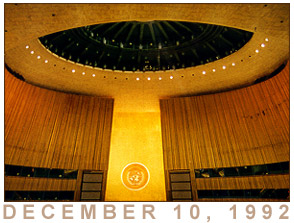
Transforming the
United Nations: The Indigenous Model
A Summary History of the Work of Native Peoples in the
International Forum
by Ingrid Washinawatok
Published by the Native American Council of New York City
Excerpt:
 THE INTERNATIONAL YEAR OF THE WORLDS INDIGENOUS PEOPLE THE INTERNATIONAL YEAR OF THE WORLDS INDIGENOUS PEOPLE
On
December 10, 1992, also International Human Rights day, the
United Nations' General Assembly inaugurated 1993 as the
International Year of the World's Indigenous People. It was
for many Indigenous peoples, a turning point in their
relationship with the United Nations, for the first time,
the international body recognized Indigenous people, even if
the recognition was mostly symbolic.
During the historic morning session, the official opening
took place with the General Assembly in full session.
Speeches were made by Secretary General Boutros
Boutros-Ghali; the President to the General Assembly, Stoyan
Ganev; Under Secretary General for Human Rights and
Coordinator for the International Year, Antoine Blanca;
Madame Daes, Chair and Rapporteur of the Working Group on
Indigenous Populations.
In his opening remarks, Secretary General Boutros
Boutros-Ghali states, "For centuries Indigenous People have
been outcasts in their own lands...Today, a welcome change
is taking place on national and international levels...The
way Indigenous People are treated by states and the
international community will be a major test of the
seriousness of our commitment to a genuinely universal human
rights regime. If we are serious about development,
political participations and human rights, we must address
the special situation of Indigenous People."
However, after the lunch break, twenty Indigenous
representatives addressed the afternoon session of the
General Assembly, which unfortunately, had been "suspended"
and was no longer in formal session. While the United
Nations called for a "new partnership" between Member States
and Indigenous Peoples, hardly anyone official was there to
hear the aspirations of the Indigenous Peoples. With that in
mind the International Year was opened.
In UN speak, "a new partnership" signifies that the UN
encourages increased international cooperation in solving
the problems faced by Indigenous Peoples in such areas as
human rights, environment, development, education and
health; increased public awareness of the issues and the
concerns of Indigenous People themselves, particularly in
regard to land, resources, and the kind of development and
change they want for their futures, their cultures, their
ways of life; increased effort to strike a balance between
the legitimate aspirations of Indigenous People and the
genuine concerns of States. In 1992 Nobel Peace Prize
Laureate, Rigoberta Menchu Tum was designated the UN
Ambassador of Goodwill for the International Year. Despite
having little resources available to her to carry out this
responsibility, she represented Indigenous peoples with
great dignity, visiting many Indigenous communities.
|